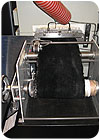
Plastic has many attributes, including light weight, corrosion resistance and design flexibility. An unlimited number of shapes and sizes of parts can easily be created with thousands of different grades of polymer. The material also appeals to engineers because it allows them to create single-piece components that simplify assembly.
Traditionally, one of the only drawbacks of plastic has been its lack of electrical conductivity. But, that’s starting to change. Nanotechnology is enabling engineers to create hybrid materials that can be processed with traditional production methods, such as injection molding and laser welding.
Polymers that are electrically conductive typically fall into three categories:
- Inherently conductive thermoset resins, such as polyaniline, polythiophene and polypyrolle.
- Inherently static-dissipative thermoplastic resins based on thermoplastic polyurethanes or similar-structure materials.
- Modified or compounded resins with conductive and static-dissipative or anti-static additives.
“We define a conductive polymer as any system that contains an additive to lower resistivity,” says Sam Dahman, Ph.D., product development engineer at RTP Co. “Unmodified plastics have a resistivity of 1016 ohm-meters; conductive additives can lower conductivity levels in steps down to the 104 ohm-meters resistivity range.”
According to Dahman, conductive compounds are available with multiple levels of resistivity, such as antistatic, static-dissipative, static control, grounding and electromagnetic interference shielding, depending on end use requirements. “Additive choice and additive loading levels affect the level of conductivity that can be obtained in a thermoplastic compound,” he points out.
To achieve true electrical conductivity in plastics, formulators often must inject additives, such as carbon or stainless steel fibers. However, that can have adverse affects on the polymer. For instance, stiffness and tensile properties often increase. Choosing the right type and combination of additives is critical to performance.
“Using conventional additives, such as carbon black or carbon fiber, seems to be reaching maturity,” says Dahman. “But, there are new additives at the beginning stages of commercialization, such as carbon nanotubes and thermoplastic alloys using inherently dissipative polymer and inherently conductive polymer technologies.”

Big Growth Potential
During the past two decades, engineers have created a wide variety of plastic alloys that are electrically and thermally conductive. Things began heating up 10 years ago, when Alan MacDiarmid, Alan Heeger and Hideki Shirakawa won the Nobel Prize in Chemistry for the discovery and development of conductive polymers. Since then, early exuberance has waned and most R&D activity has been confined to university laboratories.“Conductive polymers are a mixture of mature and evolving technologies,” says Kurt Edwards, sales and marketing manager at Lubrizol Corp. “There is a very active number of research projects throughout industry and university locations occurring for both base resins, as well as new conductive additives and structures for many evolving technologies.”
Although natural thermoplastic resins typically act as electric insulators, plastics can be formulated to have specific conductivity characteristics. “However, the word ‘conductive’ may be misleading,” warns Richard Claus, Ph.D., professor emeritus of electrical and computer engineering at Virginia Tech University and president of NanoSonic Inc. “Because, without absolute numbers, it is a relative term.
“By ‘conductive materials,’ one usually means materials that have very good electrical conductivity,” Claus points out. “Typical examples are metals such as copper, silver and aluminum. The electrical conductivity of conductive polymers is typically several orders of magnitude lower than that of metals.”
Claus and his colleagues have developed an electrically conductive nanocomposite that consists of engineered polymers and electrically conductive metal nanoclusters. They are combined through molecular-level self-assembly production techniques to produce a material called Metal Rubber. It exhibits electrical conductivity on the same order of magnitude as that of metals such as copper, silver and aluminum, but with a modulus and mass density typical of elastomers such as rubber.
“Conducting polymers have shown great promise, but have not completely matured,” adds Stephen Cheng, Ph.D., dean of the College of Polymer Science and Polymer Engineering at the University of Akron. “A lot of R&D is still being conducted on the topic worldwide. Currently, the focus of research is mainly on developing materials for practical application.
“We have known a great deal about its basic physics, but due to issues such as material stability and sample availability, its practical application is limited and does not match our expectation,” adds Cheng.
Conductive polymers are ideal for use in products where space and weight considerations are critical, such as automobiles, aircraft and portable consumer electronics. Cheng and his colleagues at the University of Akron are developing high-performance conducting polymers for both solar cells and bio-related applications.
“Common applications for conductive polymers utilize their conductivity or electroactivity,” explains Cheng. “The former includes electrostatic materials, conducting adhesives, electromagnetic shielding, artificial nerves, antistatic clothing, piezoceramics, active electronics and aircraft structures. The latter includes electrical displays, chemical, thermal and biochemical sensors, rechargeable batteries, solid electrolytes, optical computers, ion exchange membranes, actuators and switches.
According to the Freedonia Group Inc., conductive polymer demand in the United States is expected to grow 3 percent annually over the next four years. Gains will be fueled by the greater susceptibility of electrical and electronic products to damage by static discharge.

Real-World Applications
Poor conductivity can lead to undesirable consequences, such as static charge buildup that is capable of creating an electrical spark. As a result, any type of automotive or aerospace components through which fuel flows, such as pumps, filters, tanks or hoses, are ideal candidates for electrically conductive plastic.
Engineers at Robert Bosch recently faced that dilemma when developing a fuel filter housing for use in Audi A4 and A5 sedans. Traditionally, automotive fuel pumps and supply units are made from polyoxymethylene (POM).
But, to comply with the SAE J1645 standard, which addresses electrostatic discharge in fuel systems and components, the Bosch engineers were forced to use a conductive material. So, they turned to Ultraform N2320 C from BASF. The electrically conductive plastic eliminates the risk of electrostatic discharge and sparking as fuel flows through the filter.
“It acquires its excellent conductivity from carbon nanotubes,” says Juergen Demeter, product development engineer at BASF Engineering Plastics Europe. “Thanks to the type of additives and the way they have been incorporated, [the new material has retained traditional POM properties] such as toughness, dimensional stability and elastic resilience. When this material comes into contact with fuel, it is stronger and more creep resistant than conventional POM.”
The fuel filter is currently assembled at a Bosch plant in the Czech Republic, but the supplier is planning to use the new material globally. “Other automotive suppliers have expressed interest in using it, too,” says Demeter, who claims that the material can be “easily processed by laser welding and injection molding.”
Other German automotive suppliers have also been experimenting with conductive polymers. For instance, engineers at Mann+Hummel have developed a fuel filter housing made from Durethan DP BCF 30, a polyamide 6 from Lanxess that is reinforced with carbon fibers. It is a cost-effective alternative to traditional die-cast aluminum.
“Unlike die-cast aluminum, [our electrically conductive material] yields components that require little secondary finishing [to remove flash] and simplifies subsequent assembly,” says Bernhard Stoll, a technical customer service engineer with Lanxess’ semicrystalline products business unit. “The thermoplastic offers enhanced design freedom and greater weight-reducing potential.
“Sealing the housing shut with the lid is also easier,” claims Stoll. “The two components are easy to weld together in a highly automated process using ultrasound, without soiling the inside of the filter. This produces welded joints that satisfy the stringent requirements relating to tightness and strength. With die-cast aluminum, the lid and housing need to be screwed together after inserting a seal, which requires significant additional expenses.”
Aerospace engineers also see long-range potential for conductive polymers. Goodrich Corp. is currently working with the University of Dayton Research Institute (UDRI) to develop a nanomaterial with metal-like conductive properties in sizes suitable for large-scale commercial aerospace applications. They are collaborating with Owens-Corning and Renegade Materials to build and equip a facility capable of producing the hybrid composite material, dubbed “fuzzy fiber,” in sheets up to 60 inches wide.
“Aside from serving simply as structural material, composites made with fuzzy fiber can work as batteries, sensors, heaters, supercapacitors, structural health monitors and other systems whose operations are normally performed by additional components,” says Khalid Lafdi, group leader for carbon materials at UDRI. “By manufacturing structural material that can serve multiple functions, fewer parts are needed for any given application, which means reduced cost, lighter weight and greater efficiency.”
Goodrich has already committed $1 million to the R&D effort. It intends to use the hybrid composite material in new-generation nacelles, wheels, brakes and landing gear. Other potential applications include aircraft structural health monitoring and electrical de-icing systems.
“This would allow for reduced weight and complexity, along with increased efficiency over current hot-air-ducting ice removal systems,” explains Harry Arnold, vice president of enterprise technology at Goodrich.
In Australia, a biomedical engineer at the University of New South Wales is developing conductive polymers that can carry electrical signals for use in implantable medical devices, such as eyes and ears.
“Our plastics will lead to smaller devices that use safer currents and encourage nerve interaction,” says Rylie Green, Ph.D. “Our focus is on developing a plastic that makes a better neural connection.”
The process involves incorporating natural body proteins into conductive polymers, then using them as coatings on the tiny electrodes that connect implants to nerve tissue. “These biopolymers overcome problems such as scarring encountered with metal electrodes, where the body recognizes them as foreign objects and forms scar tissue, eventually shortening the useful life of the implant,” Green points out. A
Learn more about conductive polymers by reading these articles at www.assemblymag.com
- New Manufacturing Process Could Boost Demand for Conductive Plastic
- Plasma Printing Can Electrify Polymer
- Plastic Electronics May Be the Next Big Thing

